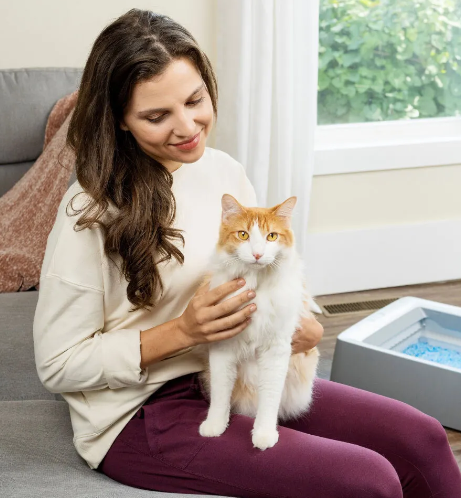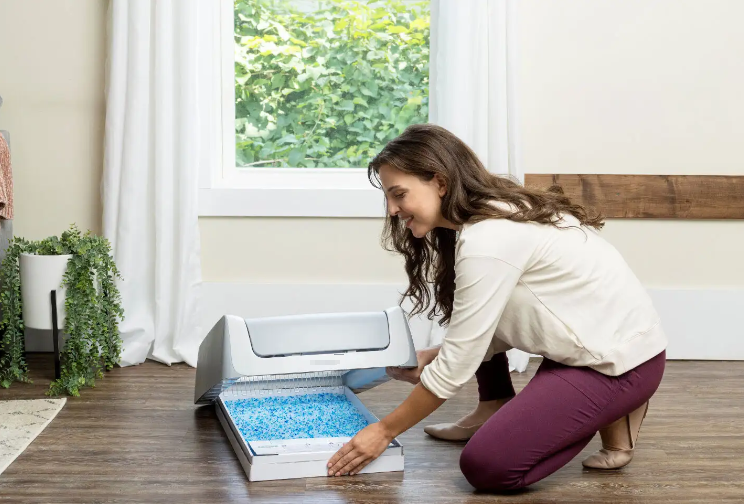
Why It’s Important to Keep the Litter Box Clean
Ever enter a public restroom, take one look around and simply turn to leave? That’s how our cats can feel when they find a litter box that hasn’t been cleaned in a while. In fact, a dirty litter box is one of the most common reasons some cats stop using their litter box. Aside from unpleasant odors and unsightly messes, a dirty litter box can lead to irritation or illness for you and your cats. If you want to keep your cat happy and healthy, and to avoid “accidents” around the house, it’s best to clean your cat’s litter box thoroughly and regularly. Your feline friend will appreciate having a consistently tidy place to do her business.
Cleaning Frequency and Litter Type
The question of how often to change litter depends on several factors. One of the most important is the type of litter you use. Today, there are more types of litter available than ever, and how often you feel like cleaning the box is one of the questions you should ask yourself when you’re shopping for litter. Let’s take a look at a few of the most popular litter types.
Clay Cat Litter
Clay litters are among the most commonly used cat litter types. They come in two forms, clumping and non-clumping. Each has its pros and cons, but generally, non-clumping clay litter needs to be changed more often than clumping litter. Cats often prefer these litter types because they closely resemble the natural soil where cats would potty outdoors. However, they are also generally the messiest, often with high dust and high tracking on your cat’s paws. A dirty clay litter box can become a muddy mess in just a couple of days. For this reason, the litter should be completely changed out at least once a week – the more often, the better. Clay litters can be less expensive than other types, but you often pay for it with more maintenance and cleaning time.
Crystal Cat Litter
Crystal cat litter is usually made of a silica compound and works by absorbing fluids more quickly and efficiently than any other litter type. Because of this, it can quickly dry out solid waste and urine, making it one of the most effective litter types for odor control as well. With almost no dust and smooth granules that don’t stick to cats’ paws, it’s also one of the best options when it comes to avoiding litter box messes. Because crystal litter is so absorbent, cat parents can generally afford to clean the box less often than they would with clay litter. And because, unlike clay litter, crystal litter does not stick to litter box surfaces or form a hard “crust”, the cleaning process will be much quicker! Crystal litter should be changed out completely every few weeks to once a month, depending on how many cats are using the same box.
Pine Cat Litter
Pine cat litter is a recycled product made from pinewood lumber waste. While effective at absorbing moisture, it becomes damp quickly and can produce a lot of fibrous dust particles that can aggravate allergies in pets and people. Pine litter is good if you want a more natural, environmentally friendly option than other litters, but the downside is that it requires frequent changing, often every one to two days. Like clay litter, pine litter should be changed out fully at least once a week. Also like clay, it can be quite heavy and bulky to handle when it has absorbed a lot of urine.
Paper Cat Litter
Paper litter is similar to pine litter in some ways. It’s often a recycled product, and is made primarily of cellulose, the main fiber in wood pulp. However, it is typically one of the least effective litter types for controlling odors, and it can become quite soft and soggy when wet, creating a surface and texture that many cats do not like. Paper litter should be changed out fully every few days like pine litter. It is generally easy to rinse out when wet, but when soggy paper litter is allowed to dry onto a surface, it can sometimes be a hassle to remove.
Cleaning Frequency in Multi-Cat Homes
So if you have more than one cat, how often should you change cat litter? The general rule is that the more cats you have, the more litter boxes you need. Managing multi-cat litter boxes can be a lot of work. Cats often prefer to have their own litter box – so from the cats’ point of view, it’s ideal to have one litter box for each cat in your home. If this isn’t possible, don’t fret; it just means you’ll have to clean each litter box more often. For a single cat with most litter types, you’ll want to change out litter completely about once a week and clean the box about once a month. So how often should you replace cat litter in a house with more than one cat? For each additional cat, you’ll usually have to roll that time back a bit, changing out most litter types every few days for a shared litter box. This is why multi-cat homes are some of the best candidates for self-cleaning litter boxes. These litter boxes keep litter fresh longer, and often use disposable trays that remove the hassle from fully changing out the litter when the time comes.

How to Dispose of Cat Litter
As with any animal waste, it’s important to dispose of cat litter safely and properly. It’s best to avoid touching litter with your hands, especially if you are pregnant, as cat feces can contain a pathogen that causes toxoplasmosis in developing infants. Always wear gloves when cleaning out a litter box, and be sure to wipe down surfaces where used litter has come into contact. Because of the risk of contamination, the best way to dispose of cat litter is in a bag, in the garbage. Some cat litter brands claim to be biodegradable or compostable, but even these products can be problematic because they are soiled with cat waste. Adding these litter products to your lawn or your compost should be done carefully, as the soil they enter should not be allowed to come in contact with food, as in a garden. Some litter brands also claim to be flushable – but most plumbers advise never flushing any cat litter, no matter what the label says, as this can cause expensive damage to your home’s plumbing system.
Keeping a clean, private potty available for your feline friend can be hard work at times, but we assure you, your cat appreciates it… wouldn’t you?
Post time: May-15-2023
